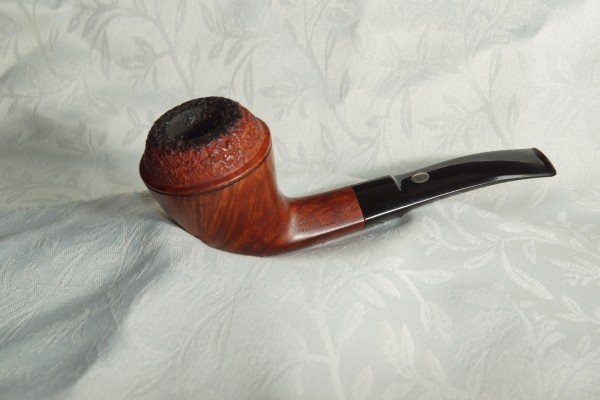Ok, here goes...
While there are many people who regard sandblasting as a form of rustication (and rightly so, I must admit), most pipemakers, merchants and collectors regard them as two entirely different categories because of the process and results.
A sandblasted finish is exactly what you think it is. Just as a sandblaster is used in removal of rust and paint in metalworking and other applications, the same process is used on the pipe stummel as a method of creating a textured finish. As this textured finish creates a "rustic" appeal to the pipe, some consider it a form of "rustication".
Just as a textured surface can be created by sandblasting, it can also be created by using many various tools to carve, gouge and scrape at the wood to give it the "rustic" appearance. These textures carved out by tools is commonly accepted as "rustication". For the purpose of keeping everyone on the same page, I think it best to keep sandblasts and (carved) rustication in seperate categories, just as pipemakers and most merchants do!
Now, here's the most important difference:
Using a sandblasting method to create a texutre will highlight the natural grain of the pipe. This method requires a well grained piece of briar and the end result is entirely dependent on the grain. Sandblasting will not mask large flaws in the briar! Many collectors prefer a blast over a rustication for those reasons.
Now, just as one can carve a horse head, nude figure, Sherlock Holmes, or anything else into a piece of wood, so also can one carve an irregular, craggy pattern into the surface of briar. This is rustication. The rustication is not at all dependent on the grain of the pipe, it can be nicely applied to pipes with very poor, undefined grain. It is an artificial, man made texture. It's also very well suited for hiding large flaws in the wood.
So there you have it! Sandblasting turns the natural grain of the wood into a "3D" relief. Rustication is an entirely "faux" texture indepenent of the quality of the wood.
PS: A couple of interesting facts...
Sandblasting is never done with sand as this is very dangerous and harmful to the lungs! The most common media used to blast pipes is glass beads mixed with a small amount of various other abrasives. Just as sandpaper comes in different "grits", so does these glass beads, with different grits yielding different degrees of definition in the texture of the blast.
Rusticated textures are carved with anything from Dremel tool bits and wire wheels, to the traditional "group of sharpened nails on the end of a handle"
Does sandblasting remove the softer grain, or the harder grain? This question has been debated to death, but those with the most hands on experience with blasting will tell you that the harder, more brittle grain is blasted away much quicker than the softer grain of which the media just bounces off. I can tell you that I am 100% sure that the harder grain is removed during blasting. No doubt.










